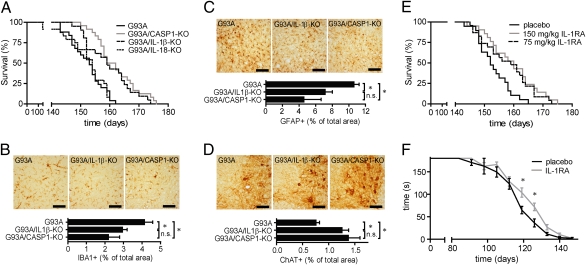Fig. 5.
Disease progression in G93A-SOD1 transgenic mice is accelerated by IL-1β and can be delayed by IL-1RA treatment. (A) Survival of G93A-SOD1 transgenic mice (152.2 ± 1.2 d; n = 25), caspase-1–deficient (162.0 ± 1.8 d; n = 24), IL-1β–deficient (159.6 ± 1.7 d; n = 21), and IL-18–deficient (152.2 ± 1.4 ds; n = 24) G93A-SOD1 transgenic mice. Caspase-1– and IL-1β–deficient mice lived significantly longer than G93A-SOD1 transgenic mice (P < 0.001). (B–D) Immunohistochemical analysis of cervical spinal cord sections of 120-d-old G93A-SOD1 transgenic mice, caspase-1–deficient G93A-SOD1 transgenic mice, and IL-1β–deficient G93A-SOD1 transgenic mice using antibodies against the microglial marker protein ionized calcium binding adaptor molecule 1 (IBA1; B), the astrocytic marker glial fibrillary acidic protein (GFAP; C), or the motor neuron marker protein choline acetyltransferase (ChAT; D). Representative images of the ventral horn area of mice with indicated genotypes, and quantification of IBA1-, GFAP-, and ChAT-positive area in the ventral horns of analyzed mice. (E) Survival of G93A-SOD1 transgenic mice treated with indicated dosages of IL-1RA (75 mg/kg: 157.8 ± 1.8 d, n = 23; 150 mg/kg: 159.4 ± 1.8 d; n = 21) or placebo (153.1 ± 1.3 d, n = 19). IL-1RA–treated mice lived significantly longer than placebo-injected mice (75 mg/kg, P = 0.0145; 150 mg/kg, P < 0.005). (F) Motor performance of IL-1RA (150 mg/kg) and placebo-treated G93A-SOD1 transgenic mice determined by the hanging-wire test. (Scale bar, 200 μm.) *P < 0.05. n.s, Not significant. Values are mean ± SEM.

